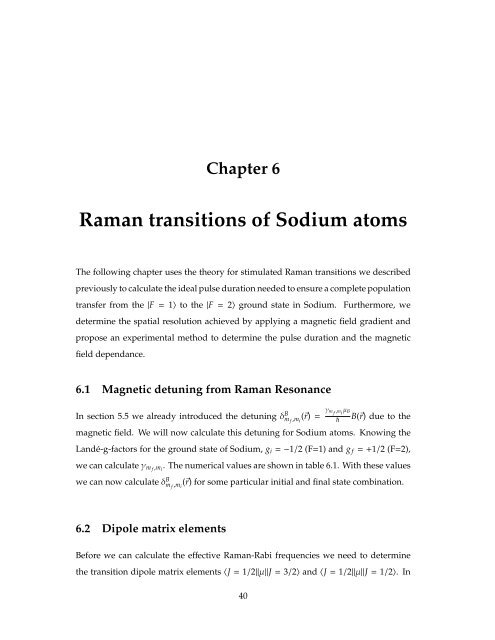Copyright by Kirsten Viering 2006 - Raizen Lab - The University of ...
Copyright by Kirsten Viering 2006 - Raizen Lab - The University of ...
Copyright by Kirsten Viering 2006 - Raizen Lab - The University of ...
Create successful ePaper yourself
Turn your PDF publications into a flip-book with our unique Google optimized e-Paper software.
Chapter 6<br />
Raman transitions <strong>of</strong> Sodium atoms<br />
<strong>The</strong> following chapter uses the theory for stimulated Raman transitions we described<br />
previously to calculate the ideal pulse duration needed to ensure a complete population<br />
transfer from the |F = 1〉 to the |F = 2〉 ground state in Sodium. Furthermore, we<br />
determine the spatial resolution achieved <strong>by</strong> applying a magnetic field gradient and<br />
propose an experimental method to determine the pulse duration and the magnetic<br />
field dependance.<br />
6.1 Magnetic detuning from Raman Resonance<br />
In section 5.5 we already introduced the detuning δB m f ,mi (r) = γm f ,m µB i<br />
B(r) due to the<br />
magnetic field. We will now calculate this detuning for Sodium atoms. Knowing the<br />
Landé-g-factors for the ground state <strong>of</strong> Sodium, gi = −1/2 (F=1) and g f = +1/2 (F=2),<br />
we can calculate γm f ,mi . <strong>The</strong> numerical values are shown in table 6.1. With these values<br />
we can now calculate δB m f ,mi (r) for some particular initial and final state combination.<br />
6.2 Dipole matrix elements<br />
Before we can calculate the effective Raman-Rabi frequencies we need to determine<br />
the transition dipole matrix elements 〈J = 1/2||µ||J = 3/2〉 and 〈J = 1/2||µ||J = 1/2〉. In<br />
40
















